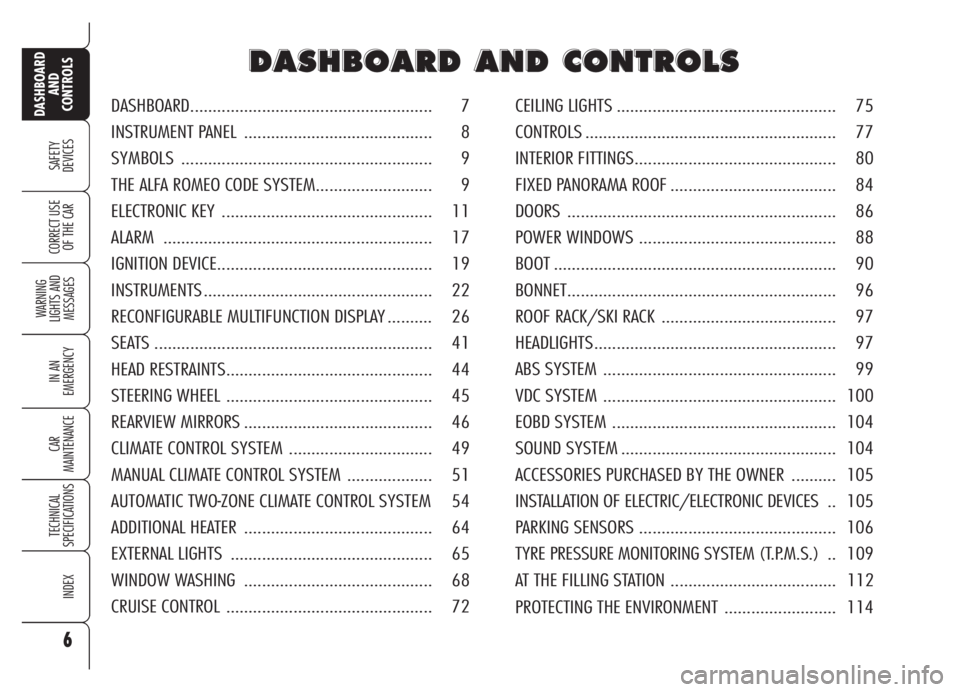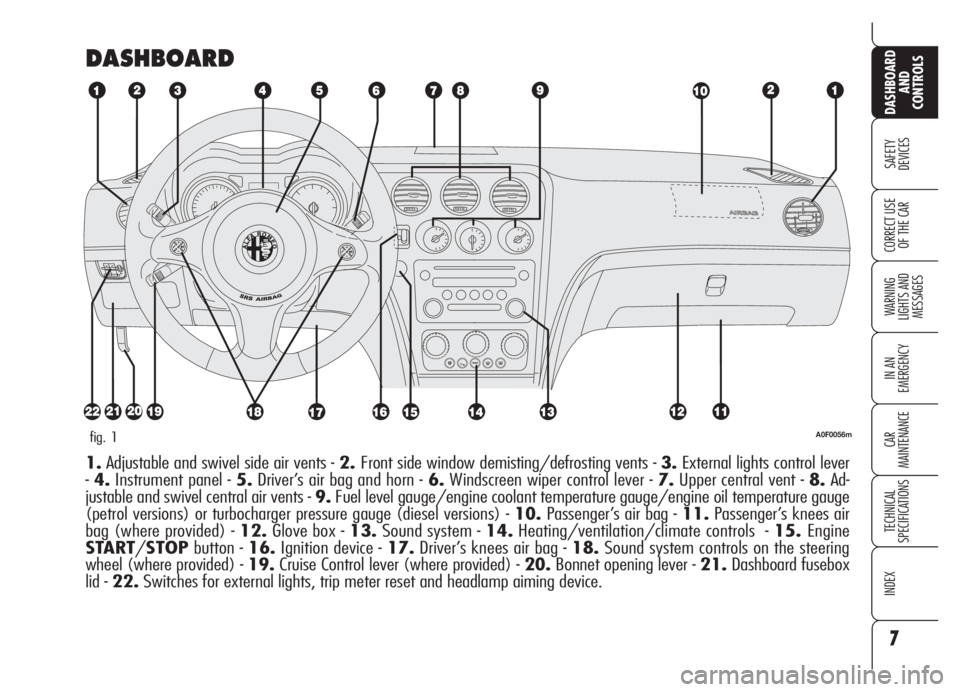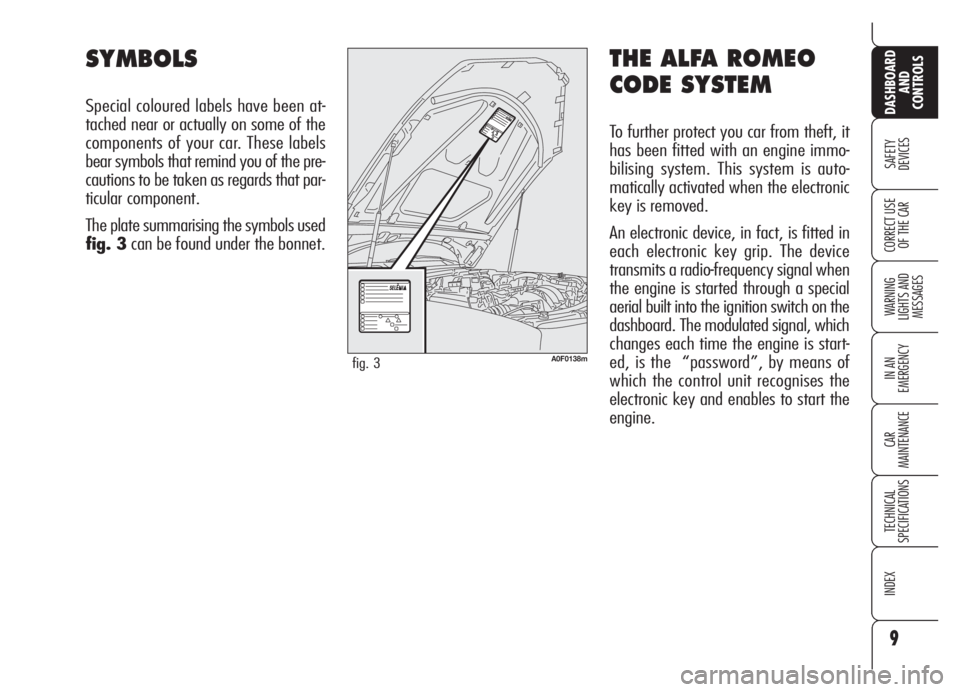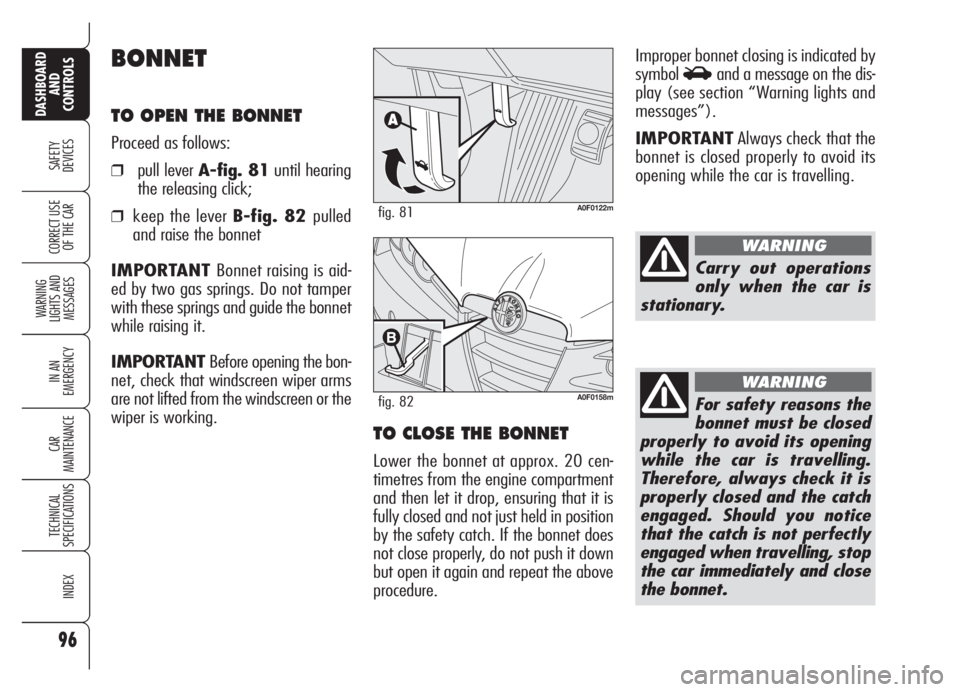2008 Alfa Romeo Brera/Spider bonnet
[x] Cancel search: bonnetPage 7 of 270

6
SAFETY
DEVICES
WARNING
LIGHTS AND
MESSAGES
IN AN
EMERGENCY
CAR
MAINTENANCE
TECHNICAL
SPECIFICATIONS
INDEX
DASHBOARD
AND
CONTROLS
CORRECT USE
OF THE CAR
D D
A A
S S
H H
B B
O O
A A
R R
D D
A A
N N
D D
C C
O O
N N
T T
R R
O O
L L
S S
CEILING LIGHTS ................................................. 75
CONTROLS ........................................................ 77
INTERIOR FITTINGS............................................. 80
FIXED PANORAMA ROOF ..................................... 84
DOORS ............................................................ 86
POWER WINDOWS ............................................ 88
BOOT ............................................................... 90
BONNET............................................................ 96
ROOF RACK/SKI RACK ....................................... 97
HEADLIGHTS...................................................... 97
ABS SYSTEM .................................................... 99
VDC SYSTEM .................................................... 100
EOBD SYSTEM .................................................. 104
SOUND SYSTEM ................................................ 104
ACCESSORIES PURCHASED BY THE OWNER .......... 105
INSTALLATION OF ELECTRIC/ELECTRONIC DEVICES .. 105
PARKING SENSORS ............................................ 106
TYRE PRESSURE MONITORING SYSTEM (T.P.M.S.) .. 109
AT THE FILLING STATION ..................................... 112
PROTECTING THE ENVIRONMENT ......................... 114 DASHBOARD...................................................... 7
INSTRUMENT PANEL .......................................... 8
SYMBOLS ........................................................ 9
THE ALFA ROMEO CODE SYSTEM.......................... 9
ELECTRONIC KEY ............................................... 11
ALARM ............................................................ 17
IGNITION DEVICE................................................ 19
INSTRUMENTS ................................................... 22
RECONFIGURABLE MULTIFUNCTION DISPLAY .......... 26
SEATS .............................................................. 41
HEAD RESTRAINTS.............................................. 44
STEERING WHEEL .............................................. 45
REARVIEW MIRRORS .......................................... 46
CLIMATE CONTROL SYSTEM ................................ 49
MANUAL CLIMATE CONTROL SYSTEM ................... 51
AUTOMATIC TWO-ZONE CLIMATE CONTROL SYSTEM 54
ADDITIONAL HEATER .......................................... 64
EXTERNAL LIGHTS ............................................. 65
WINDOW WASHING .......................................... 68
CRUISE CONTROL .............................................. 72
Page 8 of 270

7
SAFETY
DEVICES
WARNING
LIGHTS AND
MESSAGES
IN AN
EMERGENCY
CAR
MAINTENANCE
TECHNICAL
SPECIFICATIONS
INDEX
DASHBOARD
AND
CONTROLS
CORRECT USE
OF THE CAR
DASHBOARD
A0F0056mfig. 1
1.Adjustable and swivel side air vents - 2.Front side window demisting/defrosting vents - 3.External lights control lever
-4.Instrument panel - 5.Driver’s air bag and horn - 6.Windscreen wiper control lever - 7.Upper central vent - 8.Ad-
justable and swivel central air vents - 9.Fuel level gauge/engine coolant temperature gauge/engine oil temperature gauge
(petrol versions) or turbocharger pressure gauge (diesel versions) - 10.Passenger’s air bag - 11.Passenger’s knees air
bag (where provided) - 12.Glove box - 13.Sound system - 14.Heating/ventilation/climate controls - 15.Engine
START/STOPbutton - 16.Ignition device - 17.Driver’s knees air bag - 18.Sound system controls on the steering
wheel (where provided) - 19.Cruise Control lever (where provided) - 20.Bonnet opening lever - 21.Dashboard fusebox
lid - 22.Switches for external lights, trip meter reset and headlamp aiming device.
Page 10 of 270

9
SAFETY
DEVICES
WARNING
LIGHTS AND
MESSAGES
IN AN
EMERGENCY
CAR
MAINTENANCE
TECHNICAL
SPECIFICATIONS
INDEX
DASHBOARD
AND
CONTROLS
CORRECT USE
OF THE CAR
THE ALFA ROMEO
CODE SYSTEM
To further protect you car from theft, it
has been fitted with an engine immo-
bilising system. This system is auto-
matically activated when the electronic
key is removed.
An electronic device, in fact, is fitted in
each electronic key grip. The device
transmits a radio-frequency signal when
the engine is started through a special
aerial built into the ignition switch on the
dashboard. The modulated signal, which
changes each time the engine is start-
ed, is the “password”, by means of
which the control unit recognises the
electronic key and enables to start the
engine.
SYMBOLS
Special coloured labels have been at-
tached near or actually on some of the
components of your car. These labels
bear symbols that remind you of the pre-
cautions to be taken as regards that par-
ticular component.
The plate summarising the symbols used
fig. 3can be found under the bonnet.
A0F0138mfig. 3
Page 18 of 270

17
SAFETY
DEVICES
WARNING
LIGHTS AND
MESSAGES
IN AN
EMERGENCY
CAR
MAINTENANCE
TECHNICAL
SPECIFICATIONS
INDEX
DASHBOARD
AND
CONTROLS
CORRECT USE
OF THE CAR
Depending on the markets, the trigger-
ing of the alarm will activate the siren
and the hazard warning lights (for about
26 seconds). The methods of operation
and the number of cycles may vary de-
pending on the versions/markets.
A maximum number of sound/sight cy-
cles is however envisaged. Once the
alarm cycle is over, the system will re-
store its normal operation.
IMPORTANTCentral door unlocking
by the emergency electronic key will not
deactivate the alarm, therefore with
alarm on the siren will activate when
opening one of the doors or the boot.
To deactivate the siren see paragraph
“How to deactivate the alarm”.
IMPORTANTThe engine immobiliser
function is guaranteed by the Alfa
Romeo CODE system, which is auto-
matically activated when the electronic
key is removed from the ignition device.
HOW TO ACTIVATE
THE ALARM
With the doors, bonnet and boot shut
and electronic key removed from igni-
tion switch, point the electronic key in
the direction of the car, then press and
release the button
Á.
With the exception of certain markets,
the system sounds a “beep” and the
doors are locked.
Engagement of the alarm is preceded
by a self-diagnostic test characterised by
a different flashing of the driver’s door
ledA-fig. 11: if a fault is detected the
system sounds a further warning
“beep”.
ALARM
(where provided)
WHEN THE ALARM
IS TRIGGERED
The alarm comes into action in the fol-
lowing cases:
❒unlawful opening of doors, bonnet
and boot (perimetral protection);
❒attempt to start the engine with
unauthorised electronic key;
❒battery cable cutting;
❒presence of moving bodies in the
passenger’s compartment (volu-
metric protection);
❒abnormal raising/sloping of the car
(for versions/markets where ap-
plicable);
Volumetric and anti-raising protections
can be cut off by operating the front ceil-
ing light controls(see paragraph “Volu-
metric protection/Anti-raising sensor”
on the following pages).
A0F0034mfig. 11
Page 19 of 270

18
SAFETY
DEVICES
WARNING
LIGHTS AND
MESSAGES
IN AN
EMERGENCY
CAR
MAINTENANCE
TECHNICAL
SPECIFICATIONS
INDEX
DASHBOARD
AND
CONTROLS
CORRECT USE
OF THE CAR
HOW TO DEACTIVATE
THE ALARM
Press button Ë. The system will react as
follows (with the exception of certain
markets):
❒two brief flashes of the direction in-
dicators;
❒two brief “beeps”;
❒door unlocking.
The alarm can be deactivated by fitting
the electronic key into the ignition
switch.
IMPORTANTOn certain versions any
attempt to break in detected by the sys-
tem will be indicated by a warning mes-
sage on the instrument panel display
when fitting the electronic key into the
ignition switch.VOLUMETRIC PROTECTION/
ANTI-RAISING SENSORS
To make sure that the protection sensors
are working properly, check that win-
dows are shut.
This function can be cut out (for exam-
ple if you leave animals on the car) by
pressing button A-fig. 12on the front
ceiling light within 1 minute after in-
strument panel turning off.
When this function is off the button led
will turn on. Volumetric protection/an-
ti-raising sensors cut out shall be re-
peated at each instrument panel turning
off. Surveillance
When the system has been turned on,
the led A-fig. 11will flash to indicate
that the system is in the surveillance
mode. The led will flash continuously
while the system is under surveillance.
IMPORTANTOperation of the alarm
is adapted at the origin to the regula-
tions of the different countries.
Self-diagnosis and monitoring
of doors/bonnet/boot
If, after the alarm has been activated, a
second acoustic signal is heard, turn the
system off by pressing button
Ë, check
for proper locking of doors, bonnet and
boot, then turn the system on again by
pressing button
Á.
Otherwise if a door or bonnet/boot lid
is not correctly closed it will not be con-
trolled by the system. If the control sig-
nal is repeated when the doors and bon-
net/boot are closed properly this means
that the self-diagnosis function has de-
tected a system operating fault, in which
case it is necessary to contact Alfa
Romeo Authorized Services.
A0F0086mfig. 12
Page 80 of 270

79
SAFETY
DEVICES
WARNING
LIGHTS AND
MESSAGES
IN AN
EMERGENCY
CAR
MAINTENANCE
TECHNICAL
SPECIFICATIONS
INDEX
DASHBOARD
AND
CONTROLS
CORRECT USE
OF THE CARResetting the power supply
cut-off switch
(where provided)The switch is located inside the fuse box
at battery positive terminal.
To reset the power supply cut-off switch,
proceed as follows:
❒press button A-fig. 53to reset the
fuel cut-off switch;
❒open the bonnet;
A0F0126mfig. 54
Before resetting the
power supply cut-off
switch carefully inspect the car
for fuel leaks or damages to
electric devices (e.g. head-
lights).
WARNING
A0F0071mfig. 55
❒operate the retaining clips A-fig.
54and remove the protection cov-
erB;
❒press buttonC-fig. 55to reset the
power supply.
Page 97 of 270

96
SAFETY
DEVICES
WARNING
LIGHTS AND
MESSAGES
IN AN
EMERGENCY
CAR
MAINTENANCE
TECHNICAL
SPECIFICATIONS
INDEX
DASHBOARD
AND
CONTROLS
CORRECT USE
OF THE CAR
BONNET
TO OPEN THE BONNET
Proceed as follows:
❒pull lever A-fig. 81until hearing
the releasing click;
❒keep the lever B-fig. 82 pulled
and raise the bonnet
IMPORTANT Bonnet raising is aid-
ed by two gas springs. Do not tamper
with these springs and guide the bonnet
while raising it.
IMPORTANT Before opening the bon-
net, check that windscreen wiper arms
are not lifted from the windscreen or the
wiper is working.A0F0122mfig. 81
A0F0158mfig. 82
Improper bonnet closing is indicated by
symbol
Sand a message on the dis-
play (see section “Warning lights and
messages”).
IMPORTANTAlways check that the
bonnet is closed properly to avoid its
opening while the car is travelling.
Carry out operations
only when the car is
stationary.
WARNING
For safety reasons the
bonnet must be closed
properly to avoid its opening
while the car is travelling.
Therefore, always check it is
properly closed and the catch
engaged. Should you notice
that the catch is not perfectly
engaged when travelling, stop
the car immediately and close
the bonnet.
WARNING
TO CLOSE THE BONNET
Lower the bonnet at approx. 20 cen-
timetres from the engine compartment
and then let it drop, ensuring that it is
fully closed and not just held in position
by the safety catch. If the bonnet does
not close properly, do not push it down
but open it again and repeat the above
procedure.
Page 154 of 270

153
SAFETY
DEVICES
WARNING
LIGHTS AND
MESSAGES
IN AN
EMERGENCY
CAR
MAINTENANCE
TECHNICAL
SPECIFICATIONS
INDEX
DASHBOARD
AND
CONTROLS
CORRECT USE
OF THE CAR
W W
A A
R R
N N
I I
N N
G G
L L
I I
G G
H H
T T
S S
A A
N N
D D
M M
E E
S S
S S
A A
G G
E E
S S
LOW BRAKE FLUID/
HANDBRAKE ON ................................................. 155
BRAKE PAD WEAR ............................................. 155
SEAT BELTS NOT FASTENED ................................. 155
AIR BAG FAILURE................................................ 156
PASSANGER’S FRONT AIR BAGS DEACTIVATED ........ 157
ENGINE COOLANT HIGH TEMPERATURE.................. 157
ENGINE OIL HIGH TEMPERATURE .......................... 158
LOW ENGINE OIL PRESSURE/ EXHAUST OIL .......... 158
LOW BATTERY CHARGE ....................................... 158
INCOMPLETE DOOR LOCKING ............................... 159
BONNET OPEN ................................................... 159
BOOT OPEN....................................................... 159
INJECTION SYSTEM FAILURE/
EOBD SYSTEM FAILURE....................................... 159
CAR PROTECTION SYSTEM FAILURE/
STEERING LOCK INHIBITION................................. 160
ALARM FAILURE/BREAK-IN ATTEMPT/
ELECTRONIC KEY NOT RECOGNIZED ...................... 160
POSSIBLE PRESENCE OF ICE ON THE ROAD............ 161
PRE-HEATING GLOW PLUGS/
PRE-HEATING GLOW PLUG FAILURE ....................... 161
WATER IN DIESEL FUEL FILTER ............................. 162INERTIAL FUEL CUT-OFF SWITCHED ON ................. 162
ABS SYSTEM FAILURE......................................... 162
EBD SYSTEM FAILURE......................................... 163
VDC SYSTEM .................................................... 163
HILL HOLDER FAILURE ........................................ 163
ASR SYSTEM (WHEEL ANTISKID SYSTEM) ............. 163
EXTERNAL LIGHTS FAILURE .................................. 164
BRAKE LIGHTS FAILURE ....................................... 164
REAR FOGLIGHTS ............................................... 164
FRONT FOG LIGHTS ............................................ 164
SIDE/TAILLIGHTS/FOLLOW ME HOME .................. 164
DIPPED BEAM HEADLIGHTS.................................. 164
MAIN BEAM HEADLIGHTS .................................... 164
LEFT-HAND DIRECTION INDICATOR ........................ 165
RIGHT-HAND DIRECTION INDICATOR ...................... 165
LIGHT SENSOR FAILURE........................................ 165
RAIN SENSOR FAILURE......................................... 165
PARKING SENSORS FAILURE ................................ 165
FUEL RESERVE - LIMITED CRUISING RANGE ............ 165
CRUISE CONTROL .............................................. 165
DIESEL PARTICULATE FILTER CLOGGED .................. 166
ANTIPINCH SYSTEM FAILURE ............................... 166
WINDSCREEN WASHER FLUID LOW LEVEL ............. 166
SPEED LIMIT EXCEEDED ...................................... 166
T.P.M.S. SYSTEM FAILURE ................................... 166
CHECK TYRE PRESSURE ...................................... 167
LOW INFLATION PRESSURE ................................. 167
TYRE PRESSURE UNSUITABLE FOR SPEED ............. 167